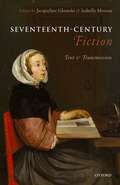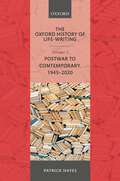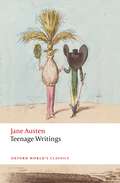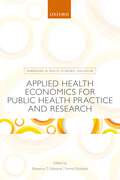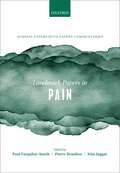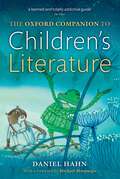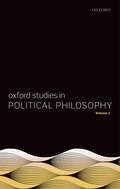- Table View
- List View
A History of Modern Political Thought in East Central Europe: Volume I: Negotiating Modernity in the 'Long Nineteenth Century'
by Balázs Trencsényi Maciej Janowski Monika Baar Maria Falina Michal KopecekA History of Modern Political Thought in East Central Europe is a two-volume project, authored by an international team of researchers, and offering the first-ever synthetic overview of the history of modern political thought in East Central Europe. Covering twenty national cultures and languages, the ensuing work goes beyond the conventional nation-centered narrative and offers a novel vision especially sensitive to the cross-cultural entanglement of discourses. Devising a regional perspective, the authors avoid projecting the Western European analytical and conceptual schemes on the whole continent, and develop instead new concepts, patterns of periodization and interpretative models. At the same time, they also reject the self-enclosing Eastern or Central European regionalist narratives and instead emphasize the multifarious dialogue of the region with the rest of the world. Along these lines, the two volumes are intended to make these cultures available for the global 'market of ideas' and also help rethinking some of the basic assumptions about the history of modern political thought, and modernity as such. The first volume deals with the period ranging from the Late Enlightenment to the First World War. It is structured along four broader chronological and thematic units: Enlightenment reformism, Romanticism and the national revivals, late nineteenth-century institutionalization of the national and state-building projects, and the new ideologies of the fin-de-siècle facing the rise of mass politics. Along these lines, the authors trace the continuities and ruptures of political discourses. They focus especially on the ways East Central European political thinkers sought to bridge the gap between the idealized Western type of modernity and their own societies challenged by overlapping national projects, social and cultural fragmentation, and the lack of institutional continuity.
A History of Modern Political Thought in East Central Europe: Volume II: Negotiating Modernity in the 'Short Twentieth Century' and Beyond, Part I: 1918-1968
by Balázs Trencsényi Michal Kopeček Luka Lisjak Gabrijelčič Maria Falina Mónika Baár Maciej JanowskiA History of Modern Political Thought in East Central Europe is a synthetic work, authored by an international team of researchers, covering twenty national cultures and 250 years. It goes beyond the conventional nation-centered narratives and presents a novel vision especially sensitive to the cross-cultural entanglement of political ideas and discourses. Its principal aim is to make these cultures available for the global 'market of ideas' and revisit some of the basic assumptions about the history of modern political thought, and modernity as such. The present volume is a sequel to Volume I: Negotiating Modernity in the 'Long Nineteenth Century'. It begins with the end of the Great War, depicting the colorful intellectual landscape of the interwar period and the increasing political and ideological radicalization culminating in the Second World War. Taking the war experience both as a breaking point but in many ways also a transmitter of previous intellectual traditions, it maps the intellectual paradigms and debates of the immediate postwar years, marked by a negotiation between the democratic and communist agendas, as well as the subsequent processes of political and cultural Stalinization. Subsequently, the post-Stalinist period is analyzed with a special focus on the various attempts of de-Stalinization and the rise of revisionist Marxism and other critical projects culminating in the carnivalesque but also extremely dramatic year of 1968. This volume is followed by Volume II: Negotiating Modernity in the 'Short Twentieth Century' and Beyond, Part II: 1968-2018.
Arabs and Empires before Islam
Arabs and Empires before Islam illuminates the history of the Arabs before the emergence of Islam, collating nearly 250 translated extracts from an extensive array of ancient sources. Drawn from a broad period between the eighth century BC and the Middle Ages, the sources include texts originally written in Greek, Latin, Syriac, Persian, and Arabic, inscriptions in a variety of languages and alphabets, and discussions of archaeological sites from across the Near East. More than twenty international experts from the fields of archaeology, classics and ancient history, linguistics and philology, epigraphy, and art history provide detailed commentary on and analysis of this diverse selection of material. Richly illustrated with sixteen colour plates, fifteen maps, and over seventy in-text images, the volume provides a comprehensive, wide-ranging, and up-to-date examination of what ancient sources had to say about the politics, culture, and religion of the Arabs in the pre-Islamic period. It offers a full consideration of the traces which the Arabs have left in the epigraphic, literary, and archaeological records, and sheds light on their relationship with their often more-powerful neighbours: the states and empires of the ancient Near East. Arabs and Empires before Islam gathers together a host of material never before collected into a single volume - some of which appears in English translation for the very first time - and provides a single point of reference for a vibrant and dynamic area of research.
Arabic-Islamic Views of the Latin West: Tracing the Emergence of Medieval Europe
by Daniel G. KönigArabic-Islamic Views of the Latin West provides an insight into how the Arabic-Islamic world perceived medieval Western Europe in an age that is usually associated with the rise and expansion of Islam, the Spanish Reconquista, and the Crusades. Previous scholarship has maintained that the Arabic-Islamic world regarded Western Europe as a cultural backwater at the periphery of civilization that clung to a superseded religion. It holds mental barriers imposed by Islam responsible for the Muslim world's arrogant and ignorant attitude towards its northern neighbours. This study refutes this view by focussing on the mechanisms of transmission and reception that characterized the flow of information between both cultural spheres. By explaining how Arabic-Islamic scholars acquired and processed data on medieval Western Europe, it traces the two-fold 'emergence' of Latin-Christian Europe — a sphere that increasingly encroached upon the Mediterranean and therefore became more and more important in Arabic-Islamic scholarly literature. Chapter One questions previous interpretations of related Arabic-Islamic records that reduce a large and differentiated range of Arabic-Islamic perceptions to a single basic pattern subsumed under the keywords 'ignorance', 'indifference', and 'arrogance'. Chapter Two lists channels of transmission by means of which information on the Latin-Christian sphere reached the Arabic-Islamic sphere. Chapter Three deals with the general factors that influenced the reception and presentation of this data at the hands of Arabic-Islamic scholars. Chapters Four to Eight analyse how these scholars acquired and dealt with information on themes such as the western dimension of the Roman Empire, the Visigoths, the Franks, the papacy and, finally, Western Europe in the age of Latin-Christian expansionism. Against this background, Chapter Nine provides a concluding re-evaluation.
Character in the Criminal Trial (Oxford Monographs on Criminal Law and Justice)
by Mike RedmayneIf a defendant is on trial for a crime such as burglary, to what extent should the fact that he has a previous conviction for burglary feature in his trial? Should the prosecution be allowed to tell the jury about the previous conviction as evidence that the defendant is more likely to have committed burglary? Should the judge give the defendant a longer sentence because he has a previous conviction? These are the fundamental questions examined in Character in the Criminal Trial. Including an in-depth analysis of the character evidence provisions of the Criminal Justice Act 2003, this book assesses the arguments for and against using character evidence to prove a defendant's guilt. It explores the sentencing provisions in the same Act, as well as the general use of criminal record and other character evidence to aggravate and mitigate sentence. Issues examined in the course of the book include: psychological and philosophical debates about the stability of character; criminological research on recidivism and the nature of criminal careers; ethical debates about the use of prior behaviour to prove current or future offending; the process of reasoning underlying the use of bad character evidence; whether bad character evidence is prejudicial; and the use of risk assessment instruments to classify offenders as dangerous. By combining insights from law, psychology, criminology, and philosophy, Redmayne reassesses the use of character in the criminal trial and reflects on the significance of the law's increasing emphasis on character.
Character in the Criminal Trial (Oxford Monographs on Criminal Law and Justice)
by Mike RedmayneIf a defendant is on trial for a crime such as burglary, to what extent should the fact that he has a previous conviction for burglary feature in his trial? Should the prosecution be allowed to tell the jury about the previous conviction as evidence that the defendant is more likely to have committed burglary? Should the judge give the defendant a longer sentence because he has a previous conviction? These are the fundamental questions examined in Character in the Criminal Trial. Including an in-depth analysis of the character evidence provisions of the Criminal Justice Act 2003, this book assesses the arguments for and against using character evidence to prove a defendant's guilt. It explores the sentencing provisions in the same Act, as well as the general use of criminal record and other character evidence to aggravate and mitigate sentence. Issues examined in the course of the book include: psychological and philosophical debates about the stability of character; criminological research on recidivism and the nature of criminal careers; ethical debates about the use of prior behaviour to prove current or future offending; the process of reasoning underlying the use of bad character evidence; whether bad character evidence is prejudicial; and the use of risk assessment instruments to classify offenders as dangerous. By combining insights from law, psychology, criminology, and philosophy, Redmayne reassesses the use of character in the criminal trial and reflects on the significance of the law's increasing emphasis on character.
International Anti-Corruption Norms: Their Creation and Influence on Domestic Legal Systems
by Cecily RoseThis book traces the creation of international anti-corruption norms by states and other actors through four markedly different institutions: the Organisation for Economic Co-operation and Development, the United Nations, the Extractive Industries Transparency Initiative, and the Financial Action Task Force. Each of these institutions oversees an international instrument that requires states to combat corruption. Yet, only the United Nations oversees anti-corruption norms that take the sole form of a binding multilateral treaty. The OECD has, by contrast, fostered the development of the binding 1997 OECD Anti-Bribery Convention, as well as non-binding recommendations and guidance associated with treaty itself. In addition, the revenue transparency and anti-money laundering norms developed through the Extractive Industries Transparency Initiative and the Financial Action Task Force, respectively, take the form of non-binding instruments that have no relationship with multilateral treaties. The creation of international anti-corruption norms through non-binding instruments and informal institutions has the potential to privilege the interests of powerful states in ways that raise questions about the normative legitimacy of these institutions and the instruments they produce. At the same time, the anti-corruption instruments created under the auspices of these institutions also show that non-binding instruments and informal institutions carry significant advantages. The non-binding instruments in the anti-corruption field have demonstrated a capacity to influence domestic legal systems that is comparable to, if not greater than, that of binding treaties. With corruption and money laundering at the forefront of political debate, International Anti-Corruption Norms provides timely expertise on how states and international institutions grapple with these global problems.
International Anti-Corruption Norms: Their Creation and Influence on Domestic Legal Systems
by Cecily RoseThis book traces the creation of international anti-corruption norms by states and other actors through four markedly different institutions: the Organisation for Economic Co-operation and Development, the United Nations, the Extractive Industries Transparency Initiative, and the Financial Action Task Force. Each of these institutions oversees an international instrument that requires states to combat corruption. Yet, only the United Nations oversees anti-corruption norms that take the sole form of a binding multilateral treaty. The OECD has, by contrast, fostered the development of the binding 1997 OECD Anti-Bribery Convention, as well as non-binding recommendations and guidance associated with treaty itself. In addition, the revenue transparency and anti-money laundering norms developed through the Extractive Industries Transparency Initiative and the Financial Action Task Force, respectively, take the form of non-binding instruments that have no relationship with multilateral treaties. The creation of international anti-corruption norms through non-binding instruments and informal institutions has the potential to privilege the interests of powerful states in ways that raise questions about the normative legitimacy of these institutions and the instruments they produce. At the same time, the anti-corruption instruments created under the auspices of these institutions also show that non-binding instruments and informal institutions carry significant advantages. The non-binding instruments in the anti-corruption field have demonstrated a capacity to influence domestic legal systems that is comparable to, if not greater than, that of binding treaties. With corruption and money laundering at the forefront of political debate, International Anti-Corruption Norms provides timely expertise on how states and international institutions grapple with these global problems.
The Egyptian Labor Market in an Era of Revolution
This book fills an important gap in the knowledge about labor market conditions in Egypt in the aftermath of the Arab Spring uprisings, and it analyzes the results of the latest round of the Egypt Labor Market Panel Survey carried out in early 2012. The chapters cover topics that are essential to understanding the conditions leading to the Egyptian revolution of 25 January 2011, including the persistence of high youth unemployment, labor market segmentation and rigidity, growing informality, and the declining role of the state as an employer. It includes the first research on the impact of the revolution and the ensuing economic crisis on the labor market, including issues such as changes in earnings, increased insecurity of employment, declining female labor force participation, and the stagnation of micro and small enterprise growth. Comparisons are made to labor market conditions prior to the revolution using previous rounds of the survey fielded in 1988, 1998, and 2006. The chapters make use of this unique longitudinal data to provide a fresh analysis of the Egyptian labor market after the Arab Spring, an analysis that was simply not feasible with previously existing data. This book is essential reading for anyone interested in the economics of the Middle East and the political economy of the Arab Spring.
The Egyptian Labor Market in an Era of Revolution
by Ragui Assaad and Caroline KrafftThis book fills an important gap in the knowledge about labor market conditions in Egypt in the aftermath of the Arab Spring uprisings, and it analyzes the results of the latest round of the Egypt Labor Market Panel Survey carried out in early 2012. The chapters cover topics that are essential to understanding the conditions leading to the Egyptian revolution of 25 January 2011, including the persistence of high youth unemployment, labor market segmentation and rigidity, growing informality, and the declining role of the state as an employer. It includes the first research on the impact of the revolution and the ensuing economic crisis on the labor market, including issues such as changes in earnings, increased insecurity of employment, declining female labor force participation, and the stagnation of micro and small enterprise growth. Comparisons are made to labor market conditions prior to the revolution using previous rounds of the survey fielded in 1988, 1998, and 2006. The chapters make use of this unique longitudinal data to provide a fresh analysis of the Egyptian labor market after the Arab Spring, an analysis that was simply not feasible with previously existing data. This book is essential reading for anyone interested in the economics of the Middle East and the political economy of the Arab Spring.
Seventeenth-Century Fiction: Text and Transmission
In the past few years, discussion of fiction in all sorts of media has intensified. The prominence of literary critics has increased, the awarding of lucrative book prizes has become more publicized, and reports of the formation of reading groups have proliferated. Seventeenth-Century Fiction: Text & Transmission responds to the present interest in the novel by offering a fresh approach to the history of early modern fiction that shifts away from the outmoded 'rise-of-the-novel' perspective and reaches beyond the boundaries of a single national literature. Starting from the literary text and looking outwards, this volume focuses on the changes in prose forms and their usage at a critical point in the evolution of modern fiction, and comes to grips with the instabilities of the novel and novella during this period. It explores the nature of seventeenth-century fiction and examines how authors fused fictional and non-fictional materials to create new, hybrid genres. Furthermore, it takes into consideration the cultural interchange between different geographical regions and languages (English, French, Spanish, Italian, Neo-Latin), and uncovers the deeper roots of seventeenth-century literary innovation, by casting light on the Continental influences on the formation of the English novel and on the role played by women's writings at the time. This landmark volume not only contributes to a more comprehensive history of the novel but promotes an authentic appreciation of early modern fiction.
Vulnerable Adults and the Law
by Jonathan HerringWe are used to thinking that most people have the capacity to make their own decisions; that they should be free to decide how to live their lives; and that it is a good thing to be self-sufficient. However, in an examination of the legal position of vulnerable adults, understood as those who have capacity under the Mental Capacity Act 2005 but are deemed impaired through vulnerability in their exercise of decision making powers, Jonathan Herring challenges that assumption. Drawing on feminist and disability perspectives he argues that we are all in fact, 'vulnerable' and we need to replace the competent, able-bodied, independent person as the norm which the law is based on and instead fashion which recognises our interdependence and mutuality. At the heart of the law is a distinction between those who have capacity and those who do not. Those who have capacity are given the full rights of the law; they are entitled to enter contracts, dispose of their property, are able to marry. Those who are deemed to lack capacity are unable to make these decisions. Their decisions are made on their behalf based on an assessment of what is in their best interests. This approach is underpinned by the principle of autonomy, and is problematic for those who are deemed 'vulnerable'. The Court of Protection and the Court of Appeal have developed a jurisdiction to deal with cases involving vulnerable adults which has been used in a wide range of cases from those involving people with early stage dementia to cases of forced marriage. This development of law has proved controversial and the courts have struggled to draw its limits and explain the justification for it. Jonathan Herring welcomes the courts willingness to protect vulnerable adults through the inherent jurisdiction, but argues that we need to go much further. It is not just particular groups such as 'the elderly' or 'the disabled' who are vulnerable, but rather vulnerability is part of the human condition. This means that caring relationships are of central significance to our society and should be at the heart of the legal system.
Vulnerable Adults and the Law
by Jonathan HerringWe are used to thinking that most people have the capacity to make their own decisions; that they should be free to decide how to live their lives; and that it is a good thing to be self-sufficient. However, in an examination of the legal position of vulnerable adults, understood as those who have capacity under the Mental Capacity Act 2005 but are deemed impaired through vulnerability in their exercise of decision making powers, Jonathan Herring challenges that assumption. Drawing on feminist and disability perspectives he argues that we are all in fact, 'vulnerable' and we need to replace the competent, able-bodied, independent person as the norm which the law is based on and instead fashion which recognises our interdependence and mutuality. At the heart of the law is a distinction between those who have capacity and those who do not. Those who have capacity are given the full rights of the law; they are entitled to enter contracts, dispose of their property, are able to marry. Those who are deemed to lack capacity are unable to make these decisions. Their decisions are made on their behalf based on an assessment of what is in their best interests. This approach is underpinned by the principle of autonomy, and is problematic for those who are deemed 'vulnerable'. The Court of Protection and the Court of Appeal have developed a jurisdiction to deal with cases involving vulnerable adults which has been used in a wide range of cases from those involving people with early stage dementia to cases of forced marriage. This development of law has proved controversial and the courts have struggled to draw its limits and explain the justification for it. Jonathan Herring welcomes the courts willingness to protect vulnerable adults through the inherent jurisdiction, but argues that we need to go much further. It is not just particular groups such as 'the elderly' or 'the disabled' who are vulnerable, but rather vulnerability is part of the human condition. This means that caring relationships are of central significance to our society and should be at the heart of the legal system.
Aiming for Global Accounting Standards: The International Accounting Standards Board, 2001-2011
by Kees Camfferman Stephen A. ZeffThe International Accounting Standards Board (IASB) and its International Financial Reporting Standards (IFRSs), have acquired a central position in the practice and regulation of financial reporting around the world. As a unique instance of a private-sector body setting standards with legal force in many jurisdictions, the IASB's rise to prominence has been accompanied by vivid political debates about its governance and accountability. Similarly, the IASB's often innovative attempts to change the face of financial reporting have made it the centre of numerous controversies. This book traces the history of the IASB from its foundation as successor to the International Accounting Standards Committee (IASC), and discusses its operation, changing membership and leadership, the development of its standards, and their reception in jurisdictions around the world. The book gives particular attention to the IASB's relationships with the European Union, the United States, and Japan, as well as to the impact of the financial crisis on the IASB's work. By its in-depth coverage of the history of the IASB, the book provides essential background information that will enrich the perspective of everyone who has to deal with IFRSs or the IASB at a technical or policy-making level.
The Oxford History of Life-Writing: Volume 7: Postwar to Contemporary, 1945-2020 (Oxford History of Life-Writing)
by Patrick HayesWith the growing urgency of questions about how to claim identity and achieve authenticity, life-writing started to acquire an unprecedented cultural importance. A range of social and economic developments, from the publishing boom in memoir writing to the rise of the internet, transformed the possibilities for self-expression. By the end of the timespan covered in this book life-writing was no longer something done mainly by important individuals who wrote their autobiography, or by sensitive souls who kept a diary. It became a truly ubiquitous phenomenon, part and parcel of the everyday formation of selfhood. Considering a diverse range of texts from across the English-speaking world, this volume places life-writing in relation to wider debates about the sociology and philosophy of modern identity, and the changing marketplace of publishing and bookselling. Yet in doing so it seeks above all to credit the extraordinary literary inventiveness which the pursuit of self-knowledge inspired in this period. Major subjects addressed include: the aftermath of World War II, including responses to the Holocaust; the impact of psychoanalysis on biography; autofiction, autrebiography, and changing ideas about authentic self-knowledge; coming out memoirs and the transformation of sexual identity; feminist exemplary writing and lyric poetry; multilingualism and intercultural life-writing; the memoir boom and the decline of intimacy; testimony narrative and memory culture; posthumanism in theory and practice; literary biography as an alternative to literary theory; literary celebrity and its consequences for literature; social media and digital life-writing.
Diverse Development Paths and Structural Transformation in the Escape from Poverty
This volume analyzes the experiences of developing countries in Asia, Latin America, and Sub-Saharan Africa, and examines how they might catch up. Based on growth performance across the developing world over the last five decades, it offers a thorough account of the possibilities to engage in such processes in an increasingly globalized world. Together, the chapters highlight the diversity and variation of development pathways and provide valuable lessons and implications for how to approach this difficult question. The book shows the importance of acknowledging that the process of development is dynamic and that the possibilities for catch up are situation dependent. At the same time it makes clear that without structural change, and in particular agricultural transformation, sustained catch up is unlikely to happen. The volume demonstrates how analysis of current growth processes in developing countries can be enriched by paying closer attention to the multifaceted nature of both economic backwardness and successful pathways to escape it.
Teenage Writings (Oxford World's Classics)
by Jane Austen'Jane Austen practising' Virginia Woolf Three notebooks of Jane Austen's teenage writings survive. The earliest pieces probably date from 1786 or 1787, around the time that Jane, aged 11 or 12, and her older sister and collaborator Cassandra left school. By this point Austen was already an indiscriminate and precocious reader, devouring pulp fiction and classic literature alike; what she read, she soon began to imitate and parody. Unlike many teenage writings then and now, these are not secret or agonized confessions entrusted to a private journal and for the writer's eyes alone. Rather, they are stories to be shared and admired by a named audience of family and friends. Devices and themes which appear subtly in Austen's later fiction run riot openly and exuberantly across the teenage page. Drunkenness, brawling, sexual misdemeanour, theft, and even murder prevail.
Teenage Writings (Oxford World's Classics)
by Jane Austen'Jane Austen practising' Virginia Woolf Three notebooks of Jane Austen's teenage writings survive. The earliest pieces probably date from 1786 or 1787, around the time that Jane, aged 11 or 12, and her older sister and collaborator Cassandra left school. By this point Austen was already an indiscriminate and precocious reader, devouring pulp fiction and classic literature alike; what she read, she soon began to imitate and parody. Unlike many teenage writings then and now, these are not secret or agonized confessions entrusted to a private journal and for the writer's eyes alone. Rather, they are stories to be shared and admired by a named audience of family and friends. Devices and themes which appear subtly in Austen's later fiction run riot openly and exuberantly across the teenage page. Drunkenness, brawling, sexual misdemeanour, theft, and even murder prevail.
Applied Health Economics for Public Health Practice and Research (Handbooks in Health Economic Evaluation)
In today's world of scare resources, determining the optimal allocation of funds to preventive health care interventions (PHIs) is a challenge. The upfront investments needed must be viewed as long term projects, the benefits of which we will experience in the future. The long term positive change to PHIs from economic investment can be seen across multiple sectors such as health care, education, employment and beyond. Applied Health Economics for Public Health Practice and Research is the fifth in the series of Handbooks in Health Economic Evaluation. It presents new research on health economics methodology and application to the evaluation of public health interventions. Looking at traditional as well as novel methods of economic evaluation, the book covers the history of economics of public health and the economic rationale for government investment in prevention. In addition, it looks at principles of health economics, evidence synthesis, key methods of economic evaluation with accompanying case studies, and much more. Looking to the future, Applied Health Economics for Public Health Practice and Research presents priorities for research in the field of public health economics. It acknowledges the role played by natural environment in promoting better health, and the place of genetics, environment and socioeconomic status in determining population health. Ideal for health economists, public health researchers, local government workers, health care professionals, and those responsible for health policy development. Applied Health Economics for Public Health Practice and Research is an important contribution to the economic discussion of public health and resource allocation.
Applied Health Economics for Public Health Practice and Research (Handbooks in Health Economic Evaluation)
by Rhiannon T. Edwards and Emma McIntoshIn today's world of scare resources, determining the optimal allocation of funds to preventive health care interventions (PHIs) is a challenge. The upfront investments needed must be viewed as long term projects, the benefits of which we will experience in the future. The long term positive change to PHIs from economic investment can be seen across multiple sectors such as health care, education, employment and beyond. Applied Health Economics for Public Health Practice and Research is the fifth in the series of Handbooks in Health Economic Evaluation. It presents new research on health economics methodology and application to the evaluation of public health interventions. Looking at traditional as well as novel methods of economic evaluation, the book covers the history of economics of public health and the economic rationale for government investment in prevention. In addition, it looks at principles of health economics, evidence synthesis, key methods of economic evaluation with accompanying case studies, and much more. Looking to the future, Applied Health Economics for Public Health Practice and Research presents priorities for research in the field of public health economics. It acknowledges the role played by natural environment in promoting better health, and the place of genetics, environment and socioeconomic status in determining population health. Ideal for health economists, public health researchers, local government workers, health care professionals, and those responsible for health policy development. Applied Health Economics for Public Health Practice and Research is an important contribution to the economic discussion of public health and resource allocation.
Landmark Papers in Pain: Seminal Papers in Pain with Expert Commentaries (Landmark Papers In)
Pain Medicine, a relatively new specialty, has proven increasingly relevant to medical practitioners in every field. The specialism of pain has emerged over the past 50 years, largely due to the persistence of experts and new medical evidence that points to its necessity. Today, it is a distinct and integral part of global medical practice. Landmark Papers in Pain offers a comprehensive inventory of over 80 key studies in pain medicine from the last 100 years. Each paper is accompanied by a concise commentary on the significance of the original findings written by an expert in pain. The reviews discuss how the paper influenced the development of the speciality, and how the findings have advanced our global comprehension of pain. Together, the selected papers and reviews chart the growth of an embryonic field into the modern speciality of pain medicine. Complied by leading specialists in the field, the papers included in this book are significant for any student, researcher, clinical practitioner, or medical historian interested in pain medicine. Organised into eight distinct topics and cross-referenced by topics and author of original paper, the book is comprehensive in its coverage and easy to use. A review of the contemporary and historical research that shaped the speciality of pain, Landmark Papers in Pain is essential reading for all medical practitioners with an interest in pain medicine.
Landmark Papers in Pain: Seminal Papers in Pain with Expert Commentaries (Landmark Papers In)
by Paul Farquhar-Smith, Pierre Beaulieu and Siân JaggarPain Medicine, a relatively new specialty, has proven increasingly relevant to medical practitioners in every field. The specialism of pain has emerged over the past 50 years, largely due to the persistence of experts and new medical evidence that points to its necessity. Today, it is a distinct and integral part of global medical practice. Landmark Papers in Pain offers a comprehensive inventory of over 80 key studies in pain medicine from the last 100 years. Each paper is accompanied by a concise commentary on the significance of the original findings written by an expert in pain. The reviews discuss how the paper influenced the development of the speciality, and how the findings have advanced our global comprehension of pain. Together, the selected papers and reviews chart the growth of an embryonic field into the modern speciality of pain medicine. Complied by leading specialists in the field, the papers included in this book are significant for any student, researcher, clinical practitioner, or medical historian interested in pain medicine. Organised into eight distinct topics and cross-referenced by topics and author of original paper, the book is comprehensive in its coverage and easy to use. A review of the contemporary and historical research that shaped the speciality of pain, Landmark Papers in Pain is essential reading for all medical practitioners with an interest in pain medicine.
The Oxford Companion to Children's Literature (Oxford Quick Reference)
by Daniel HahnThe last thirty years have witnessed one of the most fertile periods in the history of children's books: the flowering of imaginative illustration and writing, the Harry Potter phenomenon, the rise of young adult and crossover fiction, and books that tackle extraordinarily difficult subjects. The Oxford Companion to Children's Literature provides an indispensable and fascinating reference guide to the world of children's literature. Its 3,500 entries cover every genre from fairy tales to chapbooks; school stories to science fiction; comics to children's hymns. Originally published in 1983, the Companion has been comprehensively revised and updated by Daniel Hahn. Over 900 new entries bring the book right up to date. A whole generation of new authors and illustrators are showcased, with books like Dogger, The Hunger Games, and Twilight making their first appearance. There are articles on developments such as manga, fan fiction, and non-print publishing, and there is additional information on prizes and prizewinners. This accessible A to Z is the first place to look for information about the authors, illustrators, printers, publishers, educationalists, and others who have influenced the development of children's literature, as well as the stories and characters at their centre. Written both to entertain and to instruct, the highly acclaimed Oxford Companion to Children's Literature is a reference work that no one interested in the world of children's books should be without.
Oxford Studies in Political Philosophy, Volume 1 (Oxford Studies in Political Philosophy #4)
by David Sobel Steven Wall Peter VallentyneThis is the inaugural volume of Oxford Studies in Political Philosophy. Since its revival in the 1970s political philosophy has been a vibrant field in philosophy, one that intersects with jurisprudence, normative economics, political theory in political science departments, and just war theory. OSPP aims to publish some of the best contemporary work in political philosophy and these closely related subfields. This first volume features eleven papers and an introduction. The papers address a range of central topics and represent cutting edge work in the field. They are grouped into four main themes: democracy, political liberalism and public reason, rights and duties, and method.
Is Decentralization Good For Development?: Perspectives from Academics and Policy Makers
Is decentralisation good for development? This book offers insights and lessons that help us understand when the answer is 'Yes', and when it is No'. It shows us how decentralisation can be designed to drive development forward, and focuses attention on how institutional incentives can be created for governments to improve public sector performance and strengthen economies in ways that enhance citizen well-being. It also draws attention to the political motives behind decentralisation reforms and how these shape the institutions that result. This book brings together academics working at the frontier of research on decentralization with policymakers who have implemented reform at the highest levels of government and international organizations. Its purpose is to marry policymakers' detailed knowledge and insights about real reform processes with academics' conceptual clarity and analytical rigor. This synthesis naturally shifts the analysis towards deeper questions of decentralization, stability, and the strength of the state. These are explored in Part 1, with deep studies of the effects of reform on state capacity, political and fiscal stability, and democratic inclusiveness in Bolivia, Pakistan, India, and Latin America more broadly. These complex questions - crucially important to policymakers but difficult to address with statistics - yield before a multipronged attack of quantitative and qualitative evidence combined with deep practitioner insight. How should reformers design decentralisation? Part 2 examines these issues with evidence from four decades of reform in developing and developed countries. What happens after reform is implemented? Decentralization and local service provision turns to decentralization's effects on health and education services, anti-poverty programs with original evidence from 12 countries across Africa, Asia, and Latin America.







